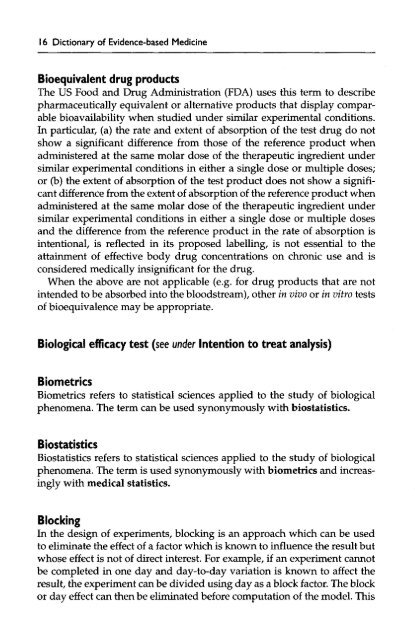Dictionary of Evidence-based Medicine.pdf
Dictionary of Evidence-based Medicine.pdf
Dictionary of Evidence-based Medicine.pdf
Create successful ePaper yourself
Turn your PDF publications into a flip-book with our unique Google optimized e-Paper software.
16 <strong>Dictionary</strong> <strong>of</strong> <strong>Evidence</strong>-<strong>based</strong> <strong>Medicine</strong><br />
Bioequivalent drug products<br />
The US Food and Drug Administration (FDA) uses this term to describe<br />
pharmaceutically equivalent or alternative products that display comparable<br />
bioavailability when studied under similar experimental conditions.<br />
In particular, (a) the rate and extent <strong>of</strong> absorption <strong>of</strong> the test drug do not<br />
show a significant difference from those <strong>of</strong> the reference product when<br />
administered at the same molar dose <strong>of</strong> the therapeutic ingredient under<br />
similar experimental conditions in either a single dose or multiple doses;<br />
or (b) the extent <strong>of</strong> absorption <strong>of</strong> the test product does not show a significant<br />
difference from the extent <strong>of</strong> absorption <strong>of</strong> the reference product when<br />
administered at the same molar dose <strong>of</strong> the therapeutic ingredient under<br />
similar experimental conditions in either a single dose or multiple doses<br />
and the difference from the reference product in the rate <strong>of</strong> absorption is<br />
intentional, is reflected in its proposed labelling, is not essential to the<br />
attainment <strong>of</strong> effective body drug concentrations on chronic use and is<br />
considered medically insignificant for the drug.<br />
When the above are not applicable (e.g. for drug products that are not<br />
intended to be absorbed into the bloodstream), other in vivo or in vitro tests<br />
<strong>of</strong> bioequivalence may be appropriate.<br />
Biological efficacy test (see under Intention to treat analysis)<br />
Biometrics<br />
Biometrics refers to statistical sciences applied to the study <strong>of</strong> biological<br />
phenomena. The term can be used synonymously with biostatistics.<br />
Biostatistics<br />
Biostatistics refers to statistical sciences applied to the study <strong>of</strong> biological<br />
phenomena. The term is used synonymously with biometrics and increasingly<br />
with medical statistics.<br />
Blocking<br />
In the design <strong>of</strong> experiments, blocking is an approach which can be used<br />
to eliminate the effect <strong>of</strong> a factor which is known to influence the result but<br />
whose effect is not <strong>of</strong> direct interest. For example, if an experiment cannot<br />
be completed in one day and day-to-day variation is known to affect the<br />
result, the experiment can be divided using day as a block factor. The block<br />
or day effect can then be eliminated before computation <strong>of</strong> the model. This










